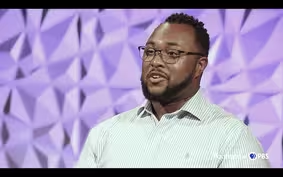Living While Black
Schools Hiring
Clip: 4/8/2021 | 5m 15sVideo has Closed Captions
A look at AISD hiring practices and efforts to diversify employees in the district.
A look inside the hiring practices of the Amarillo Independent School District.
Problems playing video? | Closed Captioning Feedback
Problems playing video? | Closed Captioning Feedback
Living While Black is a local public television program presented by Panhandle PBS
Living While Black
Schools Hiring
Clip: 4/8/2021 | 5m 15sVideo has Closed Captions
A look inside the hiring practices of the Amarillo Independent School District.
Problems playing video? | Closed Captioning Feedback
How to Watch Living While Black
Living While Black is available to stream on pbs.org and the free PBS App, available on iPhone, Apple TV, Android TV, Android smartphones, Amazon Fire TV, Amazon Fire Tablet, Roku, Samsung Smart TV, and Vizio.
Providing Support for PBS.org
Learn Moreabout PBS online sponsorship(melancholic music) - [Interviewer] What do you see in the children that you have in your school today as far as the ones of color?
Do they see enough educators and other people that look like them?
- You know, no, I don't think they see enough educators that look like them, but I think the district is trying very hard to bring qualified talent to this area to support all students.
- I can go back six, or seven years when I walked in as the human resources officer.
At that time we were over 90% white in our professional staff.
And we committed to finding a staff and developing a staff that looks like our student body.
And so, over the last seven, or eight years, we've gone from about 90.2% to right at 80%.
Our Hispanic teachers have grown from about 3% to about 15%.
Our African-American teachers have grown from about 1% to almost 3%.
And that's not nearly enough, but we're committed to that.
And part of it is about being able to recruit.
It's a national problem.
It's a national issue about making sure we've got enough African-American teachers, or Hispanic teachers, or Asian teachers.
- [Narrator] A 2016 study from the US Department of Education revealed an elementary and secondary educator workforce that is 82% white.
- I'm the first Black male principal at Bivins and I'm, even to a point I've been talking with individuals, I may be the only Black male principal in the Texas Panhandle.
So it's... We've got work to do.
(RJ chuckles) From the first time I became an assistant principal, I was excited.
Like, "We're gonna hire somebody.
"I get to be on that side of it.
"Okay, what do we need to do?"
And the first thing my principal looked at me and said, "Well, do you know anybody?"
Till it came to a point where I began to scratch my head and say, "Oh, that's why.
"That's why somebody that is a Black American "hasn't been included in the pool because "you don't know any."
That was where my first, within my first year of helping in the hiring practices I knew I could influence it a certain way.
- [Narrator] The 2016 US Department of Education report revealed that the pipeline of future teachers still is overwhelmingly white.
Individuals of color made up just 25% of college students enrolled in teacher preparation programs in the 2013 academic year.
- So three years ago we started a program called CORE.
Cultivating our own.
And we started with a cohort of about 20 that we were able, that wanna be teachers that went to WT.
As they move into this year, their junior and their senior year, we'll start providing staff development the AISD way.
The tools that we use in the classroom.
So when they graduate a year from now, they'll be ready to step into the classroom.
And what we've promised them is we'll give them a job and we'll bring them in.
We've also developed a relationship with AC and Texas Tech.
Kids can get their teaching certifications coming to AC, finishing out at Tech and really getting some really great student teaching opportunity almost a year long of internship and working in that process.
And we're excited.
- [Interviewer] Are they all minorities in these?
- They are all either minorities, or they are first-generation kiddos.
And so they are predominantly minority students - Even from a parent perspective.
I have a son in the district and I think that they're really trying to work hard at bringing role models for students in schools to show that in all aspects of schools, that there, you know... Is diversity.
- [Interviewer] And people that are successful.
- Yes, yes.
That are successful, that are professional.
That are living in their community and that are like them and something that they can aspire to.
- You have to be able to see it before you can believe it.
For any kid.
And kids have to understand, "Hey, I can be that person."
We've got some mentoring programs that are going on, helping to fill that void that we have at the moment, with some really strong African-American, Hispanic and Asian leaders in this community that go to schools (melancholic music) and really they don't have a job other than just walk around and talk to kids, make sure kids know that they're a banker, they're a lawyer, they're a, you know, whatever, a fireman.
You know, all walks of life and have the conversation about, "What do you think you can be?"
Video has Closed Captions
Clip: 4/8/2021 | 11m 16s | A look at the desegregation of Amarillo schools. (11m 16s)
Video has Closed Captions
Clip: 4/8/2021 | 3m 18s | Black Amariloans discuss a common piece of advice they got when they were younger. (3m 18s)
Video has Closed Captions
Clip: 4/8/2021 | 3m 31s | Learn where Park Hills Elementary School got its name. (3m 31s)
Video has Closed Captions
Clip: 4/8/2021 | 1m 36s | The Tascosa High School mascot and flag used to look a lot different. What changed? (1m 36s)
Providing Support for PBS.org
Learn Moreabout PBS online sponsorshipSupport for PBS provided by:
Living While Black is a local public television program presented by Panhandle PBS



















